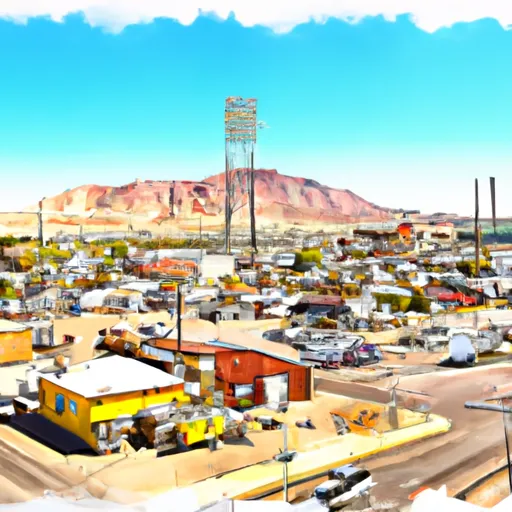-
 Snoflo Premium
Snoflo Premium
Get unlimited access to all our content
With no Ad interruptions! - Start Your Free Trial Login with existing account
Tonopah
Eden Index
Climate
8.0
•
Recreation
2.2
•
Community
•
Safeguard
4.0/10

Tonopah, Arizona is a small town located in Maricopa County, about 50 miles west of downtown Phoenix. The climate in Tonopah is characterized as a desert climate with hot summers and mild winters. Summers are very hot, with temperatures often exceeding 100°F, while winters are generally mild and comfortable, with temperatures ranging from the 60s to the 70s°F.
The hydrology of Tonopah consists mainly of groundwater sources. The town is located above the Hassayampa and Gila River Basins, and water in the area is primarily derived from underground aquifers. These aquifers are important for supporting local agriculture and maintaining water supplies for the community.
For outdoor recreation, Tonopah offers various opportunities. The nearby White Tank Mountain Regional Park is a popular destination for hiking, picnicking, and wildlife viewing. The park features numerous trails that lead to stunning desert vistas, petroglyph sites, and unique rock formations. Tonopah also provides access to the Hassayampa River Preserve, where visitors can enjoy birdwatching, nature walks, and canoeing. Additionally, the nearby Sonoran Desert National Monument offers opportunities for camping, hiking, and off-roading. These outdoor recreation opportunities allow residents and visitors to experience the beautiful natural landscape surrounding Tonopah.
What is the Eden Index?
The Snoflo Eden Index serves as a comprehensive rating system for regions, evaluating their desirability through a holistic assessment of climate health, outdoor recreation opportunities, and natural disaster risk, acknowledging the profound impact of these factors on livability and well-being.
Climate Health Indicator (CHI): 8.0
Tonopah receives approximately
186mm of rain per year,
with humidity levels near 74%
and air temperatures averaging around
21°C.
Tonopah has a plant hardyness factor of
9, meaning
plants and agriculture in this region tend to thrive here all year round.
By considering the ideal temperature range, reliable water supplies, clean air, and stable seasonal rain or snowpacks, the Climate Health Indicator (CHI) underscores the significance of a healthy climate as the foundation for quality living.
A healthy climate is paramount for ensuring a high quality of life and livability in a region, fostering both physical well-being and environmental harmony. This can be characterized by ideal temperatures, reliable access to water supplies, clean air, and consistent seasonal rain or snowpacks.
Weather Forecast
Streamflow Conditions
Lower Gila-Agua Fria
Area Rivers
Lower Gila-Agua Fria
Snowpack Depths
Lower Gila-Agua Fria
Reservoir Storage Capacity
Lower Gila-Agua Fria
Groundwater Levels
Recreational Opportunity Index (ROI): 2.2
The Recreational Opportunity Index (ROI) recognizes the value of outdoor recreational options, such as parks, hiking trails, camping sites, and fishing spots, while acknowledging that climate plays a pivotal role in ensuring the comfort and consistency of these experiences.
Access to outdoor recreational opportunities, encompassing activities such as parks, hiking, camping, and fishing, is crucial for overall well-being, and the climate plays a pivotal role in enabling and enhancing these experiences, ensuring that individuals can engage in nature-based activities comfortably and consistently.
Camping Areas
| Campground | Campsites | Reservations | Toilets | Showers | Elevation |
|---|---|---|---|---|---|
| Vulture Peak Rd - Box Wash dispersed | None | 2,541 ft | |||
| Painted Rock | 30 | 576 ft |
Nearby Fishing
Nearby Ski Areas
Catastrophe Safeguard Index (CSI):
The Catastrophe Safeguard Index (CSI) recognizes that natural disaster risk, encompassing floods, fires, hurricanes, and tornadoes, can drastically affect safety and the overall appeal of an area.
The level of natural disaster risk in a region significantly affects safety and the overall livability, with climate change amplifying these risks by potentially increasing the frequency and intensity of events like floods, fires, hurricanes, and tornadoes, thereby posing substantial challenges to community resilience and well-being.
Community Resilience Indicator (CRI):
The Community Resilience Indicator (CRI) recognizes that education, healthcare, and socioeconomics are crucial to the well-being of a region. The CRI acknowledges the profound impact of these elements on residents' overall quality of life. By evaluating educational resources, healthcare accessibility, and economic inclusivity, the index captures the essential aspects that contribute to a thriving community, fostering resident satisfaction, equity, and social cohesion.

